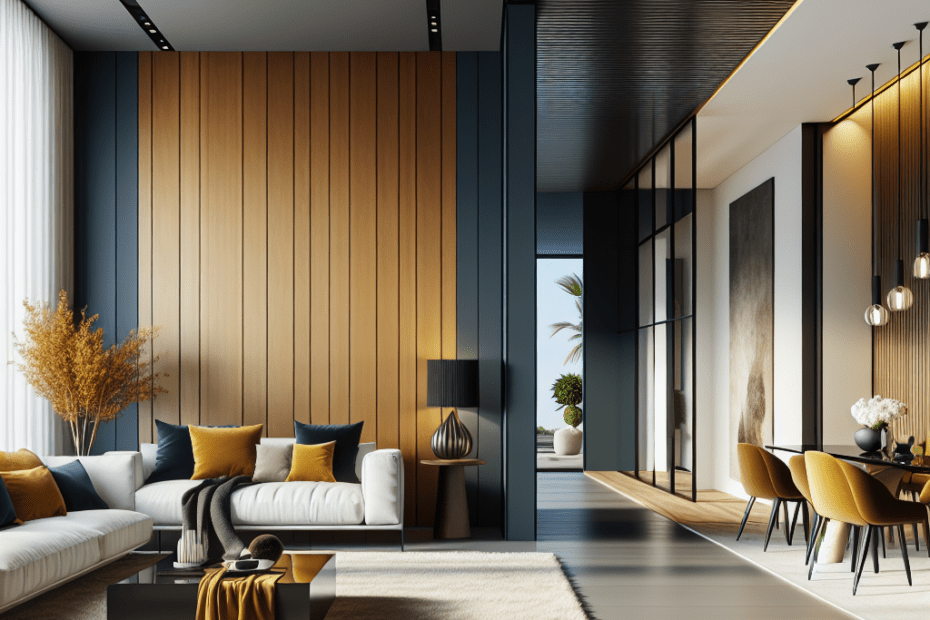“`html
The Power of Accent Walls in Modern Home Design
In modern home design, accent walls act as powerful tools to transform a space with minimal effort. They have a unique ability to create focal points and dramatically change the feel of a room. Designers and homeowners alike have found accent walls to be a cost-effective way to make a statement, bringing together style and personality.
What Makes Accent Walls Effective?
Accent walls, by definition, are walls painted or decorated differently from the other walls in a room. This distinction can come in the form of different paint colors, wallpapers, or textures. The main goal is to draw attention, adding depth and character to the space. According to a survey by Houzz, over 52% of homeowners are incorporating accent walls in their designs to add dynamism and visual interest to their homes.
Choosing the Right Wall
Choosing the right wall for an accent is crucial. They often pick a wall that is naturally the focal point of the room. In a living room, this might be the wall with the fireplace or the one that holds a television. Bedrooms might feature the wall behind the headboard. By selecting the correct wall, they ensure the accent enhances rather than detracts from the room’s existing structure.
Colors and Contrasts
The color choice for accent walls is key to their effectiveness. They often employ contrasting colors to make the accent wall stand out. For instance, a deep blue or forest green can add sophistication, while a bright yellow or terracotta can create warmth. According to a study by Behr Paint, rooms with a strategic color contrast can appear up to 18% larger than they really are.
| Accent Wall Color | Effect |
|---|---|
| Deep Blue | Adds sophistication and can make the room appear larger |
| Bright Yellow | Creates warmth and can energize the space |
| Forest Green | Gives a calming effect and adds elegance |
| Terracotta | Invites a warm, earthy feel to the room |
Textures and Patterns
Textures and patterns are another level of design that make accent walls stand out. They often opt for wallpaper, wood panels, or stone to add depth beyond just a splash of color. In particular, textured accent walls can offer a tactile experience that evokes a sense of luxury. According to the American Society of Interior Designers, textured walls are becoming increasingly popular, with a 31% rise in demand over recent years.
Integrating Other Elements
An accent wall can also be a backdrop that enhances other design elements in a room. They can integrate art pieces, shelves, or cabinets on an accent wall to create a well-rounded design. By doing so, they ensure that the accent wall complements, rather than competes with, other decorative pieces. This approach often results in a harmonious balance of color, form, and function.
Conclusion: The Modern Design Appeal
In essence, accent walls bring a versatile element into home design. They are easy to update with changing trends and personal preferences, making them a flexible design choice. For those hesitant to commit to an entire room makeover, an accent wall represents a feasible solution for refreshing a space. They see the power of accent walls in their ability to transform rooms, making them more inviting and aesthetically pleasing.
Key Takeaways
- Accent walls enhance room design by adding focus and interest.
- Choosing the right wall and color can highlight room features and even affect perceived space size.
- Textures and patterns, such as wood or stone, add depth and tactile appeal.
- Integrating decor elements on an accent wall fosters cohesive design.
- Accent walls are adaptable and cost-effective solutions in modern home design.
FAQ
- What is an accent wall?
An accent wall is a wall in a room that is painted or decorated differently from the other walls, intended to draw attention and serve as a focal point.
- Why are accent walls popular?
Accent walls are popular because they are a simple and cost-effective way to add depth, character, and visual interest to any space.
- How do they choose an accent wall?
They typically choose a wall that serves as the natural focal point of the room, such as a wall with a fireplace, TV, or behind a bed headboard.
- Can an accent wall make a room look bigger?
Yes, the right color and contrast can make a room appear larger by adding depth and focus.
- What materials can be used for an accent wall?
They can use paint, wallpaper, wood panels, stone, or any material that provides a different texture or pattern to the space.
“`
